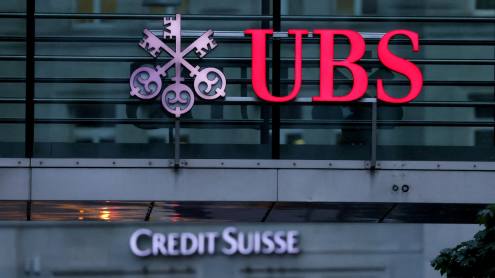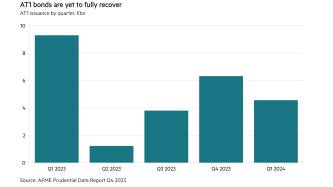With so many negative surprises dominating the eurozone in the past year, it is easy to forget the positive surprise notched up by Ireland’s largest bank. When Bank of Ireland (BoI) was ordered by the Irish regulators to raise €4.2bn in core Tier 1 capital and a further €1bn in contingent capital following a local stress test carried out in March 2011, there was a widespread assumption that the bank would follow Anglo Irish and Allied Irish into full nationalisation.
Editor's choice
Instead, the opposite occurred. Existing shareholders took up almost 60% of a rights offering in July 2011. And a group of large institutional investors – including Fidelity Investments, Canadian insurance giant Fairfax Financial Holdings and dedicated turnaround fund WL Ross & Co – brought an additional €1.12bn in new money to the table. At the same time, €1.9bn in eligible bonds was tendered in a debt-for-equity swap on Tier 1 and Tier 2 subordinated instruments.
This allowed the Irish National Pension Reserves Fund (NPRF), which had recapitalised the bank on behalf of the state in 2010, to cut its stake in BoI from 36% to just 15%. It also leaves the bank with a Tier 1 capital adequacy ratio of 15.4% based on Basel definitions, well above the 9% ratio being suggested by the European Banking Authority as part of the eurozone recapitalisation programme.
Positive signs
“It was a very clear indicator that there was private capital not just for Bank of Ireland, but also for Ireland in general, because it is the first material sign of inward investment in the financial sector that we have seen for a period of time. And the quality of the new investors was also important; they were respected investors known for their strategic time-frame,” says Sean Crowe, group treasurer at Bank of Ireland.
The willingness of investors to provide capital to a bank that is still loss-making suggested confidence in the basic elements of its turnaround strategy, which includes divesting non-core assets, mostly outside Ireland. In October 2011, BoI announced that it had completed sales worth €4.54bn, after setting out a target of €10bn by end-2013 in its interim results presentation for the first half of 2011.
Items sold so far include commercial real estate mortgage portfolios in the US and UK, UK corporate loans, international project finance, and some UK residential mortgages. The sums raised were higher than the scenario used for the March 2011 stress test, further strengthening the bank’s capital position. One of the bank’s new shareholders, US real estate investment firm Kennedy Wilson, also purchased BoI’s UK commercial real estate portfolio.
“We are pleased with the progress so far, especially because in a European context, there are certainly plenty of other people looking to sell things as we go into 2012. There are still bits and pieces to go from our non-core portfolios, and we have been very public about what that covers: residual assets such as certain project finance assets, UK intermediary-originated mortgages, and some international corporate lending portfolios,” says Mr Crowe.
Funding needs reduced
One effect of the deleveraging process is that BoI’s once vast wholesale funding needs are being rapidly reduced. This is crucial at a time when the eurozone sovereign crisis is freezing banks on the periphery out of the senior unsecured bond markets.
“The pricing is the big issue, it is a question of finding the market-clearing level [for unsecured issuance]. It does not feel like that is going to happen in the next few months,” says Mr Crowe, who was previously head of fixed income at BoI’s asset management arm.
The sovereign-guaranteed bank bonds that were helpful after the fall of Lehman Brothers in 2008 are no longer a viable option. And BoI is paying dearly for existing guarantees. Ratings downgrades and the less favourable terms under the Eligible Liabilities Guarantee Scheme (ELG) from 2010, compared with the previous Credit Institutions Financial Support Scheme initiated in 2008, have added almost 60% to BoI’s sovereign guarantee fees, which reached €239m in the first half of 2011.
The bank aims to wean itself off the ELG altogether by 2014, and the sharp reduction in debt rollover will contribute significantly to this. The bank needed to borrow about €85bn in the financial markets in 2008, which has already fallen to €60bn this year, and is forecast to decline to €30bn by 2013, which dramatically diminishes the challenge posed by bond market dislocation.
Secured markets
For the wholesale funding that BoI does need, it is currently very dependent on repo facilities from the Irish and European central banks. But the bank has taken important steps to changing that since mid-year, with a number of bilateral secured term-funding deals executed without a sovereign guarantee.
“People were surprised that we were able to get term funding done in the second half of the year, but I think they had forgotten that secured funding is not a route open to a sovereign in the way that it is for a bank. And when you are looking at a bank with core Tier 1 in excess of 15%, there is clearly a logic to it,” says Mr Crowe.
BoI has not disclosed the exact identities of the lenders, but Mr Crowe says they were foreign banks, rather than the insurance companies that have engaged in some long-term funding arrangements with banks in the UK. BoI’s deals used UK mortgages as collateral, and have raised a total of €4bn for the bank.
“The funding levels over the course of the months improved, despite the world going the other way. The improvement we saw was consistent with the narrowing of Irish gilt spreads, demonstrating a relative re-rating of Ireland as a whole, as well as a re-rating of our bank following the recapitalisation,” says Mr Crowe.
Collateral from the periphery of Europe has not been in vogue, particularly when pledged by a bank domiciled in the periphery as well, because it does not give investors risk diversification
The most recent deal, for €1.1bn, closed in October 2011 even while eurozone sovereign fears were intensifying. The maturity on this deal was early 2015, lengthening the tenor relative to trades in June and July totalling €2.9bn, which had a weighted average term of 2.2 years. While BoI did not publicly disclose the pricing on all the deals, Emer Lang, senior equity analyst at Irish stockbroker Davy, calculates that the cost of funds raised fell from 265 basis points (bps) over three-month interbank rates in June to 250bps over interbank rates on the October trade.
“Extricating itself from the costly funding guarantee is a key element of the bank’s medium-term strategy and the recapitalised bank’s ability to raise €4bn of unguaranteed secured funding against a volatile market backdrop is encouraging,” Ms Lang notes in a briefing on the October deal.
Irish appetite
The next steps to normalising funding conditions for BoI will be offering Irish collateral on secured funding, and re-entering the public markets. Both will clearly rely on the local and international economic context, but the bank is already laying the foundations. In particular, BoI retains a programme of covered bonds under Irish law using local mortgage assets in the cover pool, which are at the moment provided as repo collateral for central bank funding.
“Collateral from the periphery of Europe has not been in vogue, particularly when pledged by a bank domiciled in the periphery as well, because it does not give investors risk diversification – the performances of mortgages from Ireland and Bank of Ireland are likely to be reasonably correlated. But we have certainly seen more queries in recent months, particularly on Irish covered bonds, though not yet anyone ready to pull the trigger at a level that would be acceptable to us,” says Mr Crowe.
In addition to covered bonds already packaged up, BoI has the €1bn contingent capital notes maturing in 2016, which were issued to the NPRF in July 2011. As yet, BoI has not investigated in depth what appetite there might be for these in the secondary market. But their trigger Tier 1 capital ratio of 8.25% for conversion into equity would give investors a reasonable cushion for a coupon of 10%.
Investor appetite for Irish assets or collateral is likely to depend on the direction of the housing market, which Mr Crowe says has not completely bottomed out. House prices were down 4.2% in the second quarter of 2011, but rents have stabilised, and affordability is improving on the back of gross domestic product (GDP) growth, which reached 2.3% year on year in the second quarter. Unemployment has also stabilised, although at a high level of 14%.
“There has been a 10% swing in unit labour costs in our favour relative to the eurozone average which will not be unwound, and a heavy pick-up in foreign direct investment. But consumer demand is weak, so this recovery is still in its early stages and we are reliant on the export driver for recovery. With exports equivalent to 100% of GDP, we are basically a geared play on global growth,” says Mr Crowe.












